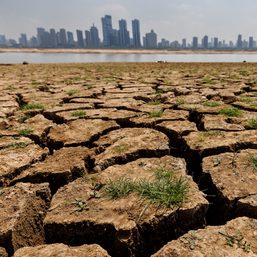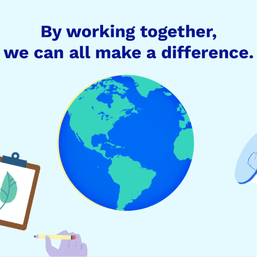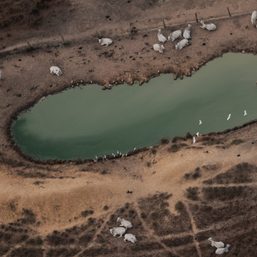SUMMARY
This is AI generated summarization, which may have errors. For context, always refer to the full article.
Ahead of a high-stakes United Nations (UN) climate summit in Glasgow, a government panel of Filipino scientists released a list of the top 10 hazards the Philippines now faces with an increasingly warmer planet.
The newly-reconstituted National Panel of Technical Experts (NPTE) presented the list to Finance Secretary and Climate Change Commission (CCC) chairperson-designate Carlos Dominguez III before he flies to Glasgow for the UN summit opening on Sunday, October 31.
The finance department issued a press release about the presentation on Wednesday, October 27,
According to the NPTE, the top 10 climate-induced risks are:
- Rising sea levels
- Coastal erosion
- Flooding
- Increasing frequency and severity of tropical cyclones
- Extreme drought
- Temperature increase and rising urban heat index
- Extreme rainfall
- Climate-influenced diseases
- Wind patterns
- Biodiversity loss
The NPTE warned that the Philippines is experiencing one of the fastest rates of sea level rise in the world and that the phenomenon is affecting around 800 municipalities.
NPTE member Doracie Zoleta Nantes said a one- to two-meter increase in seawater levels has already been observed in Metro Manila, Cavite, Pampanga, and Bulacan – among the economic hubs of Luzon with large populations.
Rising sea levels could displace small island and coastal communities and endanger food and water security.
Last August, a UN scientific body released an extremely important report that said the world is poised to hit 1.5°C warming over pre-industrial levels in the 2030s. Hitting this tipping point would bring “extreme events unprecedented in the observational record,” according to the study, called the Intergovernmental Panel on Climate Change 6th Assessment Report.
For Southeast Asia, this means rising sea levels, heat waves, drought, and more intense and frequent bouts of rain, known as “rain bombs.” Every degree of global warming is projected to bring about a 7% intensification in heavy rain events.

What do we do?
The NPTE presented an action plan to the commission, which was readily ordered adopted by Dominguez.
These are:
- Conduct climate and health impact assessments for all provinces and cities
- Set up and integrate online, real-time weather monitoring systems down to the local level
- Build network of state colleges and universities to provide support to local government units (LGUs) and communities on how to adapt to climate-induced risks and lessen carbon emissions
- Enhance local climate financing in investment and development plans of LGUs
- Encourage fishers, farmers, other workers affected by climate change to diversify their means of livelihood
- Improve access of LGUs to climate financing by aligning sustainable fund frameworks of banks with the need to encourage local climate action
- Pilot climate-related insurance programs and disaster-risk financing at the local level
- Effectively communicate climate change to vulnerable populations by making the science behind the phenomenon easier to understand
What is the NPTE?
The CCC is bound by law to establish the NPTE, which is tasked to provide technical advice “in areas of climate science, technologies, and best practices for risk assessment and enhancement of adaptive capacity of vulnerable human settlements to potential impacts of climate change,” according to the commission’s website.
Dominguez decided to change the NPTE composition after the Philippines submitted its Nationally Determined Contribution to the UN back in April.
The finance chief presented the 16 new members of the NPTE on October 13. The change in composition, he said, reflects a “change of paradigm” in the government’s efforts to address climate change, from “merely delving into theories” to implementing “practical and achievable” programs on the ground.
Dominguez personally interviewed the NPTE members who were drawn from a roster of 130 experts. They were chosen because of their experience dealing with local governments and communities, aside from their academic expertise.
Below are the 16 members and a description of their background from the Department of Finance:
- Dr. Jihan Adil, an environmental planning and engineering expert who has extensive experience coordinating the efforts of LGUs in developing comprehensive land use plans. Adil has committed to educating LGUs, especially those from Mindanao, about climate change, starting from the barangay level;
- Dr. Nathaniel Alibuyog, an agricultural engineer specializing in land and water management and currently the dean of the College of Engineering of the Mariano Marcos State University in Batac, Ilocos Norte. He will help the CCC in maximizing the management of land and water resources for sustainable use;
- Dr. Zenaida Andrade, a chemical engineer who is both an educator and a specialist in the fields of chemical engineering, pollution control, and waste management. With her background, she can explore how wastewater can be part of a circular economy;
- Dr. Wilfredo Campos, an expert in biological oceanography, coastal ecology and ecosystems, coral reef ecology, and fisheries. He is advocating better management of the country’s fishery resources to address the impact of rising ocean temperatures on our dwindling fish supply;
- Dr. Gay Defiesta, who specializes in agricultural economics and environmental accounting, and served as vice chancellor for academic affairs at the University of the Philippines (UP) in the Visayas. She advocates stronger partnerships between communities and the academe in implementing climate change-related initiatives;
- Dr. Ramon Lorenzo Luis Guinto, an expert in climate change and public health. Focused on what he termed as “planetary health,” he is now training future doctors at the St. Luke’s Medical Center College of Medicine so they can become competent in caring not just for people but also the environment. He is determined to devise ways of engaging the LGUs in efforts to address the long-term effects of climate change on public health;
- Dr. Eduardo Mangaoang, an expert in upland, lowland, and coastal forest landscape restoration and conservation. He aims to replicate in other provinces his ongoing engagements in the modeling of communities in Eastern Samar for preparedness, response, and recovery activities against climate-induced disasters. Mangaoang wants climate change-vulnerable communities to make climate action an integral part of their culture and way of life;
- Dr. Jimmy Masagca, an expert in fisheries and mangroves. He has done studies on how fisheries and mangrove resource management can aid in disaster risk reduction in the typhoon-prone island of Catanduanes. He has immersed himself in coastal communities vulnerable to climate change to explain to people why they need to be concerned about rising sea levels and ocean warming;
- Dr. Susan Mercado, a public health and food security expert with extensive experience at the international, national, and local levels. She was a former undersecretary at the Department of Health and is currently director of the Food Systems and Resiliency Program at the Hawaii Public Health Institute. She pointed out that the widespread changes in weather patterns could impact public health and spawn more diseases;
- Dr. Richard Muallil, a marine scientist and a recognized expert in coastal resource management and marine protected areas. He was recognized as one of the Ten Outstanding Young Men of the Philippines for Marine Science and Conservation for his work in educating dynamite fishers about the need to preserve the reefs and converting them into reef defenders. Muallil will help find ways to mitigate the effects of increasing ocean acidity and rising sea levels on the country’s marine resources;
- Dr. Emma Porio, a specialist in climate and disaster resilience. She has underscored the need to translate scientific concepts into language that people will understand to achieve our goal of a whole-of-society approach in fighting climate change;
- Dr. Patricia Ann Sanchez, a specialist in disaster risk management and water resource assessment who has been working on the hydrological modeling and simulation of floods and droughts. She will help the CCC in optimizing the use of water resources;
- Engineer Merriam Santillan, a geodetic engineer and the dean of the College of Engineering and Geosciences of the Caraga State University. She has been involved in numerous flood hazard mapping projects in Mindanao using remote sensing technologies. She is determined to not just contribute to our climate initiatives through her expertise but also to produce top-notch geodetic engineers in the country;
- Dr. Encarnacion Emilia Yap, a post-harvest fisheries specialist and fisheries professional who is the dean of the College of Fisheries and Ocean Sciences at UP Visayas. Yap has been educating fishers about the adverse effects of climate change on their means of livelihood and has been helping them implement climate mitigation measures. Moreover, she has instituted in her college what the government plans to do nationwide – a ban on single-use plastics;
- Dr. Maria Angela Zafra, an expert in inclusive business models, sustainable tourism, and gender inclusivity. She advocates getting businesses involved in sustainable practices and climate finance. She believes the challenge to address climate change does not solely rely on the government as the private sector must play a large role in mobilizing financial resources to achieve the Philippines’ NDC; and
- Dr. Doracie Zoleta Nantes, a specialist in geography, hazards studies, and extreme weather events. She believes that LGUs should be involved in the fight against climate change and that this crisis and its devastating effects should be explained to people in a language that they will understand.
– Rappler.com
This story was produced as part of the 2021 Climate Change Media Partnership, a journalism fellowship organized by Internews’ Earth Journalism Network and the Stanley Center for Peace and Security.
Rappler is doing live updates and reporting on COP26 in Glasgow. Check this page for our coverage.
Add a comment
How does this make you feel?


![[OPINION] Momentum for climate justice](https://www.rappler.com/tachyon/2022/01/TL-Odette-Climate-Justice-January-21-2022-Part-2.jpg?resize=257%2C257&crop=82px%2C0px%2C720px%2C720px)

![[ANALYSIS] After Glasgow: What’s next for climate?](https://www.rappler.com/tachyon/2021/12/cop26.jpg?resize=257%2C257&crop_strategy=attention)
There are no comments yet. Add your comment to start the conversation.